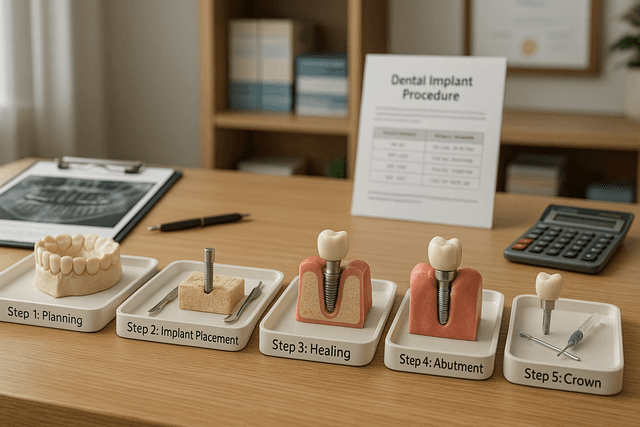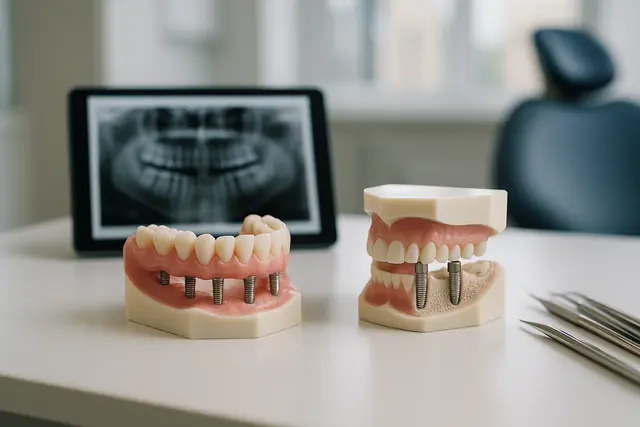Prosthodontics
4 min read
Sep 03, 2025
Dental Implant Procedure: Steps Explained From Start to Finish
Missing teeth can impact more than just your appearance, they can affect how you speak, eat, and feel about yourself. Dental implants offer a long-lasting solution that looks and feels like natural teeth. Understanding how the process works can help you feel more confident about your decision.

Missing teeth can mess with more than just your smile. They affect chewing, speech, and confidence. That’s where the dental implant comes in, a game-changing solution in modern dentistry. Whether you lost a single tooth or need full mouth dental implants, the process can seem a little mysterious at first. But don't worry, we’ve got you covered with this step-by-step guide to dental implants.
Dental Implant Evaluation and Treatment Plan
First things first: your dental implant journey starts with a personalized treatment plan. Your dentist will assess your oral health, medical history, and goals. You’ll probably get dental x-rays or a 3D scan to check the jawbone and see if it’s strong enough to support the implant.
If your jawbone isn’t quite up to the task, a bone graft may be needed. This minor surgery helps build a sturdy foundation for your new implant. Think of it like reinforcing a house before adding a fancy new deck.
Implant Surgery and Anesthesia Options
Once you're cleared as a good candidate for the procedure, it's time for implant surgery. This is typically an outpatient surgery, meaning you can go home the same day. Local anesthesia is usually all you need, though sedation is an option if you’re feeling extra nervous (totally normal, by the way).
During implant placement, your dental professional will insert a small titanium post into the jawbone. This implant post acts like a natural tooth root, supporting the structure of your new artificial tooth.
The titanium implant is biocompatible, meaning your body will accept it without a fight. But before we get too far ahead, there's a critical healing period ahead.
Osseointegration and Healing
This is the part where patience comes in handy. After implant surgery, your jawbone and the implant start a bonding process called osseointegration. This is where the magic happens.
Osseointegration (yes, it’s a mouthful) is the process where the implant and bone fuse together. It creates a rock-solid anchor for your new tooth. The process can take several months, depending on how fast your body heals.
Following the surgery, you might notice some tenderness in your gum or jaw. Stick with soft foods, follow your dentist’s advice, and keep up with regular dental visits to monitor your progress.
Placing the Abutment
Once the implant is nice and snug in your jawbone, it’s time for the next step: placing the abutment. This is a small connector that goes on top of the implant and holds your new crown in place. Sometimes the abutment is placed during the initial implant placement, but other times it requires a separate procedure.
Placing the abutment usually involves a second minor surgery, where your dentist exposes the top of the implant and attaches the abutment. It might sound scary, but it’s quick and fairly painless with the right anesthesia.
Creating the Crown and Final Restoration
Now for the exciting part: your new smile. After your gums heal around the abutment, your dentist will take impressions of your mouth to create a crown that fits perfectly.
This crown is custom-made to match your natural teeth in shape, size, and color. It's the final piece of the puzzle that completes the tooth replacement. Once it's secured to the top of the implant, you’ll have a tooth that looks and feels like a natural one.
Whether you're getting a single implant or a full dental bridge supported by multiple implants, this final step restores your function, appearance, and confidence.
Full Mouth Dental Implants and Dentures
For those missing most or all of their teeth, full mouth dental implants offer a strong and lasting solution. Instead of replacing every single tooth with an implant, dentists can use four implants or more to support an entire arch.
This approach provides a stable alternative to traditional dentures, which can slip or feel uncomfortable. With full arch or full mouth options, implants can restore your smile and give you back the confidence to eat, speak, and laugh freely.
Dentures can also be supported by implants, giving you the best of both worlds. They feel more secure and function more like natural teeth. That’s a win-win in our book.
Dental Implants Can Restore Function and Confidence
Dental implants can restore not just your smile, but your quality of life. From eating your favorite foods again to laughing without covering your mouth, the benefits go way beyond the surface.
They can help:
Prevent jawbone loss
Support facial structure
Improve overall oral health
Unlike a dental bridge, implants stand alone, no need to mess with your healthy smile.
And the best part? They’re built to last. With proper care and regular dental checkups, dental implants are one of the most reliable tooth replacement options out there.
Getting a Dental Implant Is a Big Decision
Let’s be real: getting a dental implant is a commitment. The dental implant process takes time, sometimes months from start to finish. But that time is spent building something strong, beautiful, and built just for you.
From the moment you start the implant journey to the day you bite into your first apple with your new teeth, every step is designed to ensure long-term success. Your dentist and dental team will guide you through it with expertise, compassion, and maybe a few cheesy dental jokes.
Avoiding Implant Failure and Staying Healthy
As amazing as implants are, they’re not totally invincible. Implant failure can happen if you skip care, smoke, or ignore gum disease. Brushing, flossing, and keeping up with regular dental visits are crucial.
Also, be sure to follow any post-op instructions your dental professionals provide. Good habits around the dental implant go a long way toward a healthy smile that lasts a lifetime.
How Long Does the Dental Implant Process Take?
The full dental implant process can take several months because it involves multiple stages, including healing time. After the implant post is placed in the jawbone, osseointegration (the fusion of bone and implant) usually requires 3–6 months. The overall timeline varies depending on whether you need bone grafting, the number of implants, and how quickly your body heals.
Is Dental Implant Surgery Painful?
Most patients report that implant surgery is less painful than they expected. Local anesthesia is typically used, and sedation can be added if needed. While some soreness and swelling are normal afterward, these symptoms are usually manageable with over-the-counter pain medication and proper aftercare. Discomfort often subsides within a few days.
What Are the Main Steps of the Dental Implant Procedure?
The process typically involves five main steps:
Consultation and treatment plan – Your dentist evaluates your oral health and takes scans.
Implant placement – A titanium post is surgically inserted into your jawbone.
Healing and osseointegration – The implant bonds with your bone for stability.
Abutment placement – A small connector is added to support the crown.
Crown placement – A custom-made crown is secured, completing your new tooth.
Can Dental Implants Fail?
Yes, though failure is rare when proper care is taken. Risk factors include smoking, untreated gum disease, poor oral hygiene, or certain health conditions that affect healing. Following your dentist’s instructions, maintaining good oral hygiene, and attending regular checkups greatly reduce the chances of implant failure.
Read Next
Related Posts

Prosthodontics
Implant Supported Dentures Overview
Missing teeth can impact more than just your smile, they can affect your confidence, comfort, and even your diet. Fortunately, modern dentistry offers a solution that’s both secure and natural-looking: implant-supported dentures. This innovative approach blends the stability of implants with the convenience of dentures to create a long-lasting, life-improving upgrade.
5 min read
Oct 29, 2025

Prosthodontics
Implant Overdentures Explained: The Hybrid Solution to Missing Teeth
Missing teeth can impact everything from your ability to eat to your self-confidence. While traditional dentures have long been a go-to solution, they often fall short in comfort and stability. Implant overdentures offer a modern alternative that combines the security of dental implants with the convenience of removable dentures, a true upgrade for those looking to reclaim their smile.
6 min read
Oct 29, 2025

Prosthodontics
Implant Retained Dentures Explained
Considering implant-retained dentures? You're not alone. As modern dentistry evolves, more people are turning to this secure, natural-feeling alternative to traditional dentures. This guide will walk you through what they are, how they work, and why they might be the solution you've been looking for.
4 min read
Oct 28, 2025
Don’t have time to research every dentist around you?
See why 30k+ patients trusted us